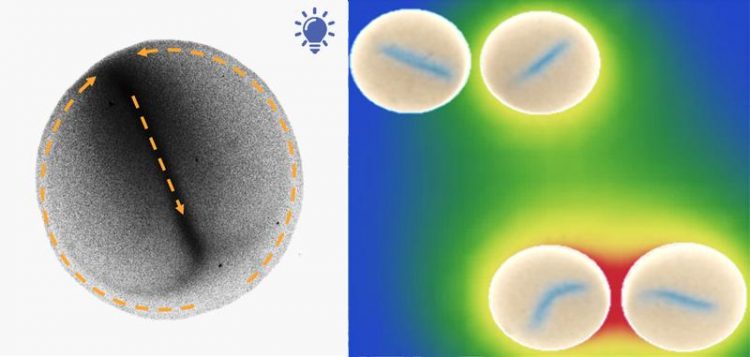Drops of nanoparticles self-stir and communicate

Single drop with active nanoparticles that collectively organize (left); and several drops that communicate to coordinate their flow patterns (right). MPI für Intelligente Systeme
Communication and organized behaviour is considered to be the quintessence of living systems. For example, understanding how cellular patterns form is one of the most interesting phenomena of biological systems.
Insights into nature’s ability to actively self-organize can be harnessed by science in many ways, potentially leading to the design of a new class of interactive materials. Scientists from the Micro, Nano and Molecular Systems Lab at the Max Planck Institute for Intelligent Systems (MPI-IS) in Stuttgart have now succeeded in bringing drops of nanoparticles to exhibit internal self-organization and to communicate.
Their work “Interface-mediated spontaneous symmetry breaking and mutual communication between drops containing chemically active particles” was published in Nature Communications on 5th May 2020.
The researchers from the MPI-IS teamed up with scientists from the University of Seville in Spain. Together they found a simple yet highly interactive form of artificial active matter. They used powders of titanium dioxide (TiO2) and added them together with peroxide to a water droplet.
“The particles start to catalyse chemical reactions when they are illuminated with UV light. Although the individual particles are not motile, things are very different when many of them come together. By enclosing a large number of nanoparticles in a drop, we were able to get a very dense system of active particles and observe them”, explains Dhruv Singh, the first author of the study.
Until recently, he was a Postdoctoral Fellow at the MPI-IS and is now an Assistant Professor at the Indian Institute of Technology Bhilai in India. “The droplet containing the TiO2 particles was carefully placed inside oil. Upon illumination we saw how flows developed spontaneously within the drop and the TiO2 particles self-organized into a well-defined pattern,” Singh adds.
The researchers see this phenomenology emerging through a novel mechanism involving the interplay between the geometrical confinement provided by the drop and the flow-driving compositional changes at the surface of the drop (Marangoni stresses) that are created by the chemical reactions occurring among the particles.
Remarkably, these active drops not only show collective organization inside each drop, but they also interact with neighbouring drops and “coordinate” their respective internal flows, even when they are far apart.
“Our study illustrates how simple active particles, if present in large numbers and at high density, can give rise to macroscopically ordered systems and chemical communication” says Peer Fischer who heads the Micro, Nano and Molecular Systems Lab at the MPI-IS and who is a Professor of Physical Chemistry at the University of Stuttgart.
“We have realized highly dense active systems and found a model system to study collective phenomena. The drops can be used to organize flows and pump solutions”, Singh concludes.
“Interface-mediated spontaneous symmetry breaking and mutual communication between drops containing chemically active particles” D.P. Singh, A. Domínguez, U. Choudhury, S. N. Kottapalli, M.N. Popescu, S. Dietrich, and P. Fischer, Nature Communications 5th May 2020.
Peer Fischer
Professor, University of Stuttgart
Max Planck Research Group Leader
Micro, Nano, and Molecular Systems
fischer@is.mpg.de
https://is.mpg.de/news/drops-of-nanoparticles-self-stir-and-communicate
Media Contact
All latest news from the category: Life Sciences and Chemistry
Articles and reports from the Life Sciences and chemistry area deal with applied and basic research into modern biology, chemistry and human medicine.
Valuable information can be found on a range of life sciences fields including bacteriology, biochemistry, bionics, bioinformatics, biophysics, biotechnology, genetics, geobotany, human biology, marine biology, microbiology, molecular biology, cellular biology, zoology, bioinorganic chemistry, microchemistry and environmental chemistry.
Newest articles

How marine worms regenerate lost body parts
The return of cells to a stem cell-like state as the key to regeneration. Many living organisms are able to regenerate damaged or lost tissue, but why some are particularly…

Nano-scale molecular detective
New on-chip device uses exotic light rays in 2D material to detect molecules. Researchers have developed a highly sensitive detector for identifying molecules via their infrared vibrational “fingerprint”. Published in Nature…

Novel CAR T-cell therapy
… demonstrates efficacy and safety in preclinical models of HER2-positive solid tumors. The p95HER2 protein is found expressed in one third of HER2+ tumors, which represent 4% of all tumors….



